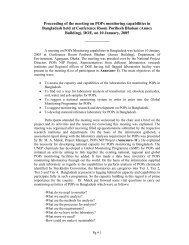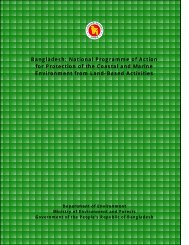Draft CMP HH - the Department of Environment
Draft CMP HH - the Department of Environment
Draft CMP HH - the Department of Environment
You also want an ePaper? Increase the reach of your titles
YUMPU automatically turns print PDFs into web optimized ePapers that Google loves.
Coastal and Wetland Biodiversity Management Project BGD/99/G31<br />
Hakaluki Haor <strong>Draft</strong> Conservation Management Plan<br />
4.2 Global Significance and Threatened Species<br />
The freshwater swamp forest (Barringtonia acutangula, Pongamia pinnata, and Crataeva nurvala)<br />
is <strong>the</strong> native vegetation <strong>of</strong> much <strong>of</strong> <strong>the</strong> region and indeed <strong>of</strong> much <strong>of</strong> Bangladesh. It has disappeared<br />
from <strong>the</strong> country except for <strong>the</strong> small patches remaining in <strong>the</strong> Nor<strong>the</strong>ast Region <strong>of</strong> which Hakaluki<br />
is a part. The swamp forests have now been seriously degraded with only a few patches surviving.<br />
The scrub is restricted near <strong>the</strong> slopes at <strong>the</strong> village highlands.<br />
The list <strong>of</strong> plants recorded from Hakaluki Haor includes threatened aquatic plants. The most<br />
important species that are locally and regionally threatened are Rosa clinophylla (guji kanta), Oryza<br />
rufipogon and Euryale ferox which have been threatened by over-harvesting for fuel-wood. Rosa<br />
clinophylla is an important wild relative <strong>of</strong> cultivated roses. , while Oryza rufifogon is a wild<br />
relative <strong>of</strong> <strong>the</strong> deepwater rice variety and is widely sought by plant breeders for developing diseaseresistant<br />
rice varieties and flood-tolerant roses.<br />
The wetland supports a number <strong>of</strong> ‘life-support plants’ that are used by local people when crop<br />
foods are scarce. One example includes Asparagus racemosus which is important for its medicinal<br />
values; <strong>the</strong> plant grows in winter in bushy areas around <strong>the</strong> beels, but has now become scarce as a<br />
result <strong>of</strong> over-exploitation. Insert as appendix updated table which lists <strong>the</strong> life support plants <strong>of</strong><br />
Hakaluki Haor and <strong>the</strong>ir uses from project document.<br />
The Hakaluki Haor ecosystem supports one reptile, 11 birds, and two mammal species listed as<br />
vulnerable and endangered categories in <strong>the</strong> IUCN red data book. It also supports six reptiles, four<br />
birds and two mammals listed under CITES schedule I and one amphibian, four reptiles, three birds<br />
and four mammals shown under CITES schedule II. Insert updated table <strong>of</strong> threatened wildlife<br />
species.<br />
While Hakaluki Haor was once known as a “fishmine”, its fish stocks are now increasingly<br />
threatened. Nandina (Labeo nandina), Angrot (Labeo angra), Pangus (Pangasius pangasius),<br />
Mahashol (Tor tor) and Sarputi (Puntius sarana) are all endemic to <strong>the</strong> region and nearly extinct,<br />
and Catla (Catla catla) and Mrigel (Cirhinus mrigala) are threatened (NERP, 1994 a,b,c).<br />
4.3 Threats and Pressures<br />
The Hakaluki Haor ecosystem is subject to a variety <strong>of</strong> threats and pressures. These are summarised<br />
as follows:<br />
• Loss <strong>of</strong> reedland and swamp forest areas<br />
due to conversion for agriculture and <strong>the</strong><br />
removal trees for building and firewood<br />
• Reduction in surface area and depth <strong>of</strong><br />
mo<strong>the</strong>r fisheries and o<strong>the</strong>r aquatic<br />
habitats (beels) due to sedimentation,<br />
drainage and river diversion for<br />
irrigation. Sedimentation is largely a<br />
result <strong>of</strong> logging in India in <strong>the</strong><br />
watersheds <strong>of</strong> <strong>the</strong> rivers that feed<br />
Hakaluki Haor<br />
• Degradation <strong>of</strong> reedland and grassland<br />
habitats due to overgrazing within <strong>the</strong><br />
Haor<br />
• Degradation <strong>of</strong> aquatic habitat due to<br />
agro-chemical (herbicides and pesticides)<br />
pollution from tea estates<br />
• Loss <strong>of</strong> reproductive capacity <strong>of</strong> fishery<br />
due to inappropriate and unsustainable<br />
fishing practices including <strong>the</strong> use <strong>of</strong><br />
illegal nets and poison<br />
• Unsustainable levels <strong>of</strong> fuelwood<br />
collection<br />
Prepared by UNOPS Consultant Mr. Sulma Warne August/ September 2005 for Project BGD/99/G31 7





